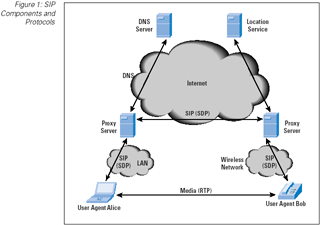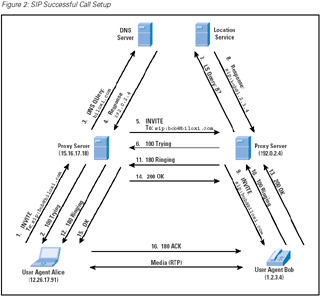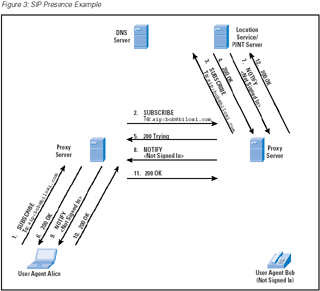 |
User location: Users can move to other locations and access their telephony or other application features from
remote locations. |
 |
User availability: This step involves determination of the willingness of the called party to engage in
communications. |
 |
User capabilities: In this step, the media and media parameters to be used are determined. |
 |
Session setup: Point-to-point and multiparty calls are set up, with agreed session parameters. |
 |
Session management: This step includes transfer and termination of sessions, modifying session parameters, and
invoking services. |
 |
Client: A client is any network element that sends SIP requests and receives SIP responses. Clients may or may not
interact directly with a human user. User agent clients and proxies are clients. |
 |
Server: A server is a network element that receives requests in order to service them and sends back responses to
those requests. Examples of servers are proxies, user agent servers, redirect servers, and registrars. |
 |
User Agent: The user agent resides in every SIP end station. It acts in two roles:
 |
User Agent Client (UAC): Issues SIP requests |
 |
User Agent Server (UAS): Receives SIP requests and generates a response that accepts, rejects, or redirects the request |
|
 |
Redirect Server: The redirect server is used during session initiation to determine the address of the called
device. The redirect server returns this information to the calling device, directing the UAC to contact an alternate Universal
Resource Identifier (URI). A URI is a generic identifier used to name any resource on the Internet. The URL used for Web
addresses is a type of URI. See RFC 2396 [1] for more detail. |
 |
Proxy Server: The proxy server is an intermediary entity that acts as both a server and a client for the purpose
of making requests on behalf of other clients. A proxy server primarily plays the role of routing, meaning that its job is to
ensure that a request is sent to another entity closer to the targeted user. Proxies are also useful for enforcing policy (for
example, making sure a user is allowed to make a call). A proxy interprets, and, if necessary, rewrites specific parts of a
request message before forwarding it. |
 |
Registrar: A registrar is a server that accepts REGISTER requests and places the information it receives (the SIP
address and associated IP address of the registering device) in those requests into the location service for the domain it
handles. |
 |
Location Service: A location service is used by a SIP redirect or proxy server to obtain information about a
callee's possible location(s). For this purpose, the location service maintains a database of SIP-address/ IP-address
mappings. |
 |
A user of an online service |
 |
An appearance on a multiline phone |
 |
A mailbox on a messaging system |
 |
A telephone number at a gateway service |
 |
A group (such as "sales" or "help desk") in an organization |
 |
REGISTER: Used by a user agent to notify a SIP configuration of its current IP address and the URLs for which it
would like to receive calls |
 |
INVITE: Used to establish a media session between user agents |
 |
ACK: Confirms reliable message exchanges |
 |
CANCEL: Terminates a pending request, but does not undo a completed call |
 |
BYE: Terminates a session between two users in a conference |
 |
OPTIONS: Solicits information about the capabilities of the callee, but does not set up a call |
 |
Provisional (1xx): The request was received and is being processed. |
 |
Success (2xx): The action was successfully received, understood, and accepted. |
 |
Redirection (3xx): Further action needs to be taken in order to complete the request. |
 |
Client Error (4xx): The request contains bad syntax or cannot be fulfilled at this server. |
 |
Server Error (5xx): The server failed to fulfill an apparently valid request. |
 |
Global Failure (6xx): The request cannot be fulfilled at any server. |
 |
Media streams: A session can include multiple streams of differing content. SDP currently defines audio, video,
data, control, and application as stream types, similar to the MIME types used for Internet mail. |
 |
Addresses: SDP indicates the destination addresses, which may be a multicast address, for a media stream. |
 |
Ports: For each stream, the UDP port numbers for sending and receiving are specified. |
 |
Payload types: For each media stream type in use (for example, telephony), the payload type indicates the media
formats that can be used during the session. |
 |
Start and stop times: These apply to broadcast sessions, for example, a television or radio program. The start,
stop, and repeat times of the session are indicated. |
 |
Originator: For broadcast sessions, the originator is specified, with contact information. This may be useful if a
receiver encounters technical difficulties. |











































